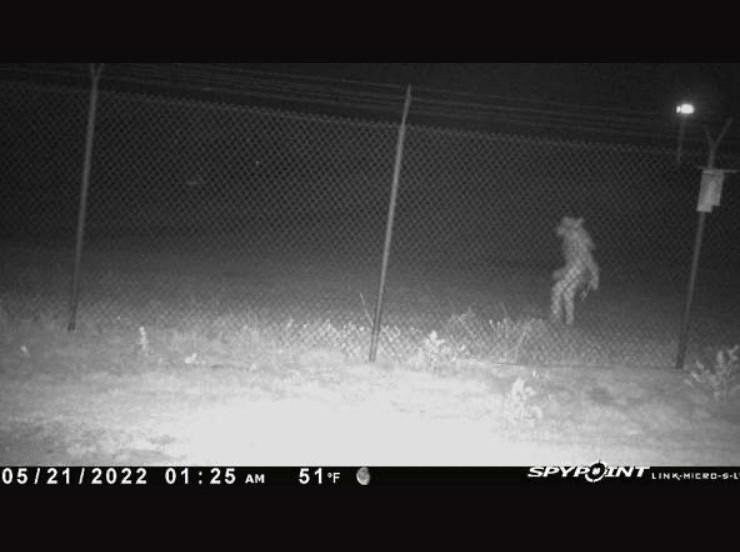In the Great Plains of the American West, from at least Montana to Nebraska, there have been reports of an animal that seems to be a hyena. With a sloping back and hyena-like features, this beast was known to the Ioway Indians as the shunka warak'in. Similar creatures, with different names, were reported from the lands of other tribes. This animal was generally described as having dark fur, often black and sometimes red. The shaggy areas were distributed in a different way than on wolves. White settlers also thought they had seen this creature, and some were even mounted as trophies. Although the present wherabouts of these trophies is now unknown, one famous trophy had a picture taken of it, although it might have been a strange-looking wolf mounted by an incompetent taxidermist. Only DNA testing could settle the question.
After all the later is a supposed extinct North American Wolf Hyena hybrid as this picture shows of one shot and preserved in the 19th Century.
![[shunka.jpg]](https://blogger.googleusercontent.com/img/b/R29vZ2xl/AVvXsEgMIDb__zwQ0Kw5MOjFF6nEXzzZ8-qm98S4eFUkLQRq2AST9c3B4rTtxQJKCN5NAN8vc6Cy0tLmRN3WU7BgjigTi_gSQVX1aQKMGSKNoRFLTvyJMceqWY2Bd1BcICcbWiD6n-03Ig/s1600/shunka.jpg)
Shunka Warak'in
In the late 19th century, the Hutchins family moved into an area of Montana along the Madison River's West Fork, in Broadwater County. They were soon to report encounters with a mysterious canine beast known to Native Americans.
One of the descendants of the original clan was zoologist Ross Hutchins. In 1977, he would write Trails to Nature's Mysteries: The Life of a Working Naturalist. Within this book is reference to one of the most obscure creatures to grace North America's cryptozoological landscape. The following account is reproduced from that book.
One winter morning my grandfather was aroused by the barking of the dogs. He discovered that a wolflike beast of dark color was chasing my grandmother's geese. He fired his gun at the animal but missed. It ran off down the river, but several mornings later it was seen again at about dawn. It was seen several more times at the home ranch as well as at other ranches ten or fifteen miles down the valley. Whatever it was, it was a great traveler...
Those who got a good look at the beast described it as being nearly black and having high shoulders and a back that sloped downward like a hyena. Then one morning in late January, my grandfather was alerted by the dogs, and this time he was able to kill it. Just what the animal was is still an open question. After being killed, it was donated to a man named Sherwood who kept a combination grocery and museum at Henry Lake in Idaho. It was mounted and displayed there for many years. He called it ringdocus.
An Ioway Indian named Lance Foster approached Loren Coleman in 1995 and informed him of traditions existing in that tribe of an animal called a shunka warak'in ('Carrying-Off-Dogs') which cried like a human when killed. Foster's descriptions of an animal that looked something like a hyena and the existence of one in an Idaho museum are testimony that the animal killed at the Hutchins ranch was a Shunka Warak'in.
Coleman speculates that the creature may have represented a survival of a prehistoric species known as Borophagus, although my own researches into the animal makes it seem even more likely that it may belong to another prehistoric species, a creodont known as Hyaenodon montanus. H. montanus was a rather lightly built member of the Neohyaenodon subspecies
And these pictures shows the alleged Chupacabra caught in Texas this summer.
Oh well.....there are lots more Chupacabra still out there.Creature ID'd As Coyote, Not Chupacabra
updated 8:32 a.m. MT, Fri., Nov. 2, 2007
SAN MARCOS, Texas - The results are in: The ugly, big-eared animal found this summer in southern Texas is not the mythical, bloodsucking chupacabra. It's just a plain old coyote.Biologists at Texas State University announced Thursday night they had identified the hairless doglike creature.
But the Shunka Warakin is extinct. Or perhaps not....
Wolf,dog,Shunka Warakin?Posted by Mark on February 24, 2007, 11:04 am
Did anyone ever here of the dna results on that wolf creature they shot from a helicopter in Nov 2006 in Montana,that killed 120 sheep? It was 106 lbs,& orangeish color.In the 1800's a settler in Montana shot & mounted what they called Ringdocus,the Indians called it Shunka Warakin ("carrying off dogs").I have a picture of the mount in a book I have.Anyway both storys r neat but I never read a follow up story on the dna results.Some said it could've been a wolf from the great lakes region but I never saw an orange wolf out here.Mabey a Wolf-dog X. Who knows?
Your True Tales
August 2007 - Page 6Shunka Warakin
by JamesI was eight in 1992 and went camping with my friends in his backyard. We made camp and lit a fire. We were in the tents when a shadow was cast on the side. We thought it was a dog at first and I went outside to chase it off. But it was not a dog. The most I remember is its eyes, they were red. The fur was black and reminded me of a hog. It smelled awful. Its front legs were longer than the back legs. It just stared at me and then it just walked back into the woods.
I talked to an Native friend of mine and he heard of it. My wife brought home a book called Weird Georgia and it had a picture and an article about it. The picture made the hair stand up on the back of my neck. The book called it a "wog". We Googled "wog" but didn't get much, but then we found a picture of "shunka warakin" and the hair stood up again. I live in southern Georgia and actively deer hunt, but have never seen another creature like this - and hope never too.
Cue eerie music....
Find blog posts, photos, events and more off-site about:
Monsters, myths,cryptid,Shunka Warakin,coyote, legends,Chupacabra,Texas,cryptozoology,











